JEEP WRANGLER 2012 JK / 3.G Owners Manual
Manufacturer: JEEP, Model Year: 2012, Model line: WRANGLER, Model: JEEP WRANGLER 2012 JK / 3.GPages: 124, PDF Size: 5.48 MB
Page 91 of 124
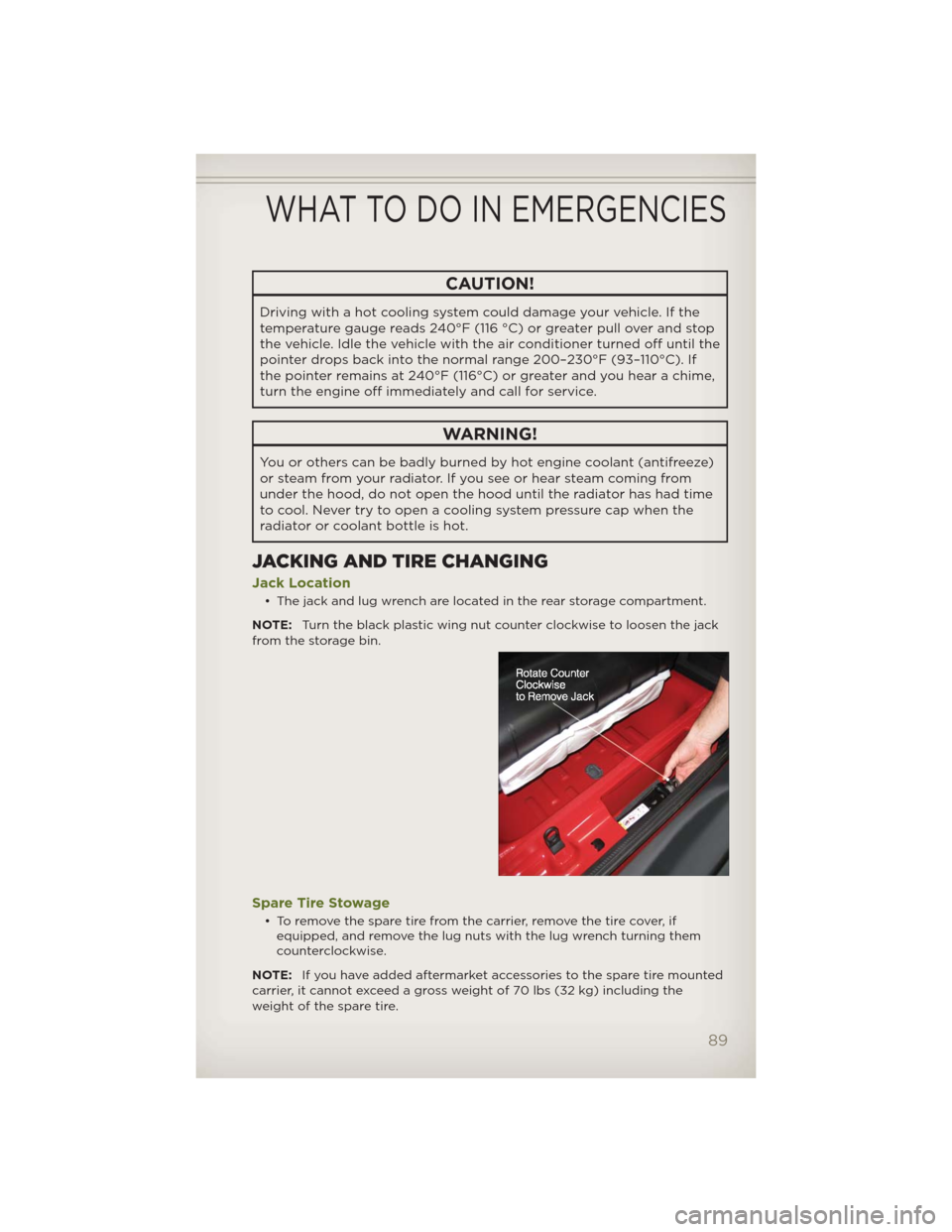
CAUTION!
Driving with a hot cooling system could damage your vehicle. If the
temperature gauge reads 240°F (116 °C) or greater pull over and stop
the vehicle. Idle the vehicle with the air conditioner turned off until the
pointer drops back into the normal range 200–230°F (93–110°C). If
the pointer remains at 240°F (116°C) or greater and you hear a chime,
turn the engine off immediately and call for service.
WARNING!
You or others can be badly burned by hot engine coolant (antifreeze)
or steam from your radiator. If you see or hear steam coming from
under the hood, do not open the hood until the radiator has had time
to cool. Never try to open a cooling system pressure cap when the
radiator or coolant bottle is hot.
JACKING AND TIRE CHANGING
Jack Location
• The jack and lug wrench are located in the rear storage compartment.
NOTE:Turn the black plastic wing nut counter clockwise to loosen the jack
from the storage bin.
Spare Tire Stowage
• To remove the spare tire from the carrier, remove the tire cover, if
equipped, and remove the lug nuts with the lug wrench turning them
counterclockwise.
NOTE:If you have added aftermarket accessories to the spare tire mounted
carrier, it cannot exceed a gross weight of 70 lbs (32 kg) including the
weight of the spare tire.
WHAT TO DO IN EMERGENCIES
89
Page 92 of 124
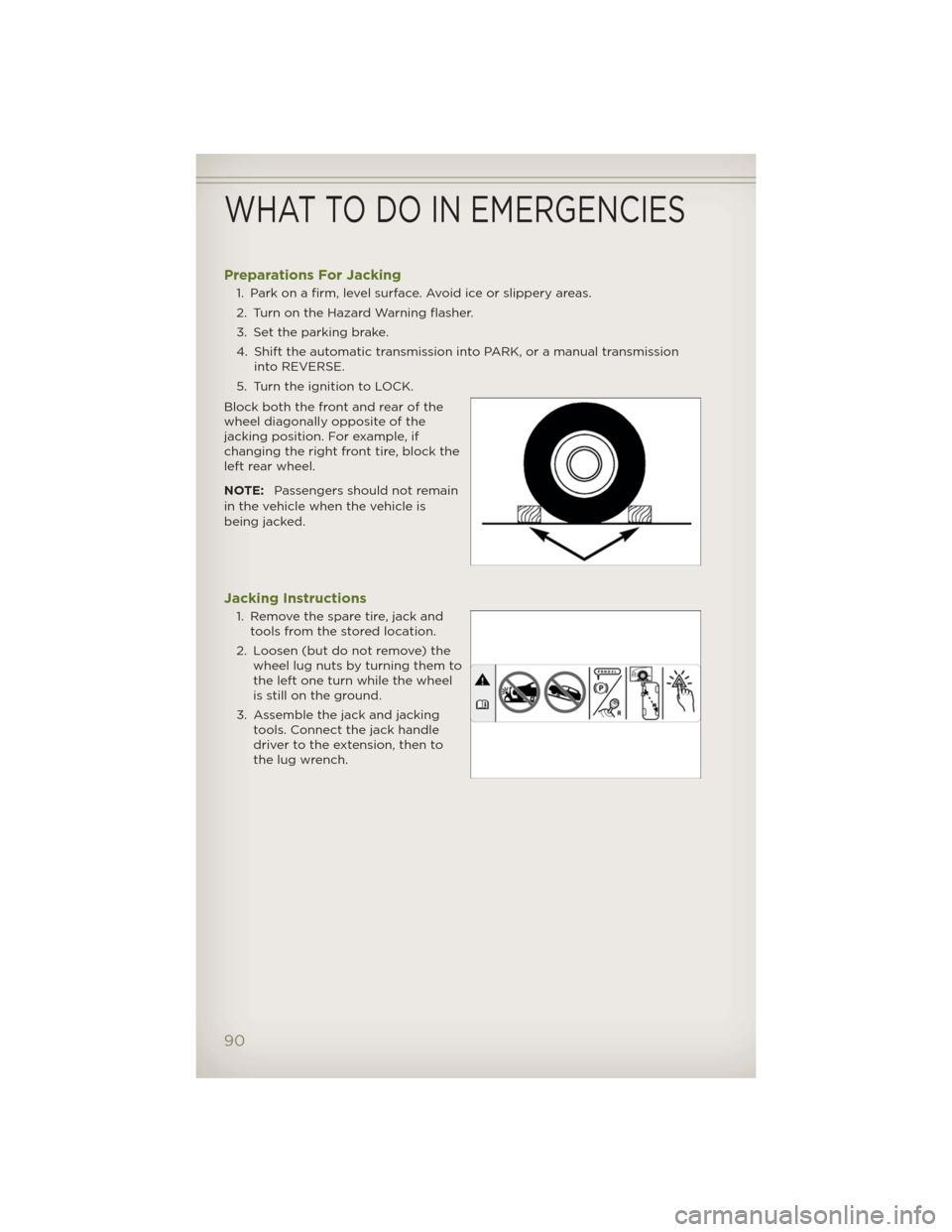
Preparations For Jacking
1. Park on a firm, level surface. Avoid ice or slippery areas.
2. Turn on the Hazard Warning flasher.
3. Set the parking brake.
4. Shift the automatic transmission into PARK, or a manual transmission
into REVERSE.
5. Turn the ignition to LOCK.
Block both the front and rear of the
wheel diagonally opposite of the
jacking position. For example, if
changing the right front tire, block the
left rear wheel.
NOTE:Passengers should not remain
in the vehicle when the vehicle is
being jacked.
Jacking Instructions
1. Remove the spare tire, jack and
tools from the stored location.
2. Loosen (but do not remove) the
wheel lug nuts by turning them to
the left one turn while the wheel
is still on the ground.
3. Assemble the jack and jacking
tools. Connect the jack handle
driver to the extension, then to
the lug wrench.
WHAT TO DO IN EMERGENCIES
90
Page 93 of 124
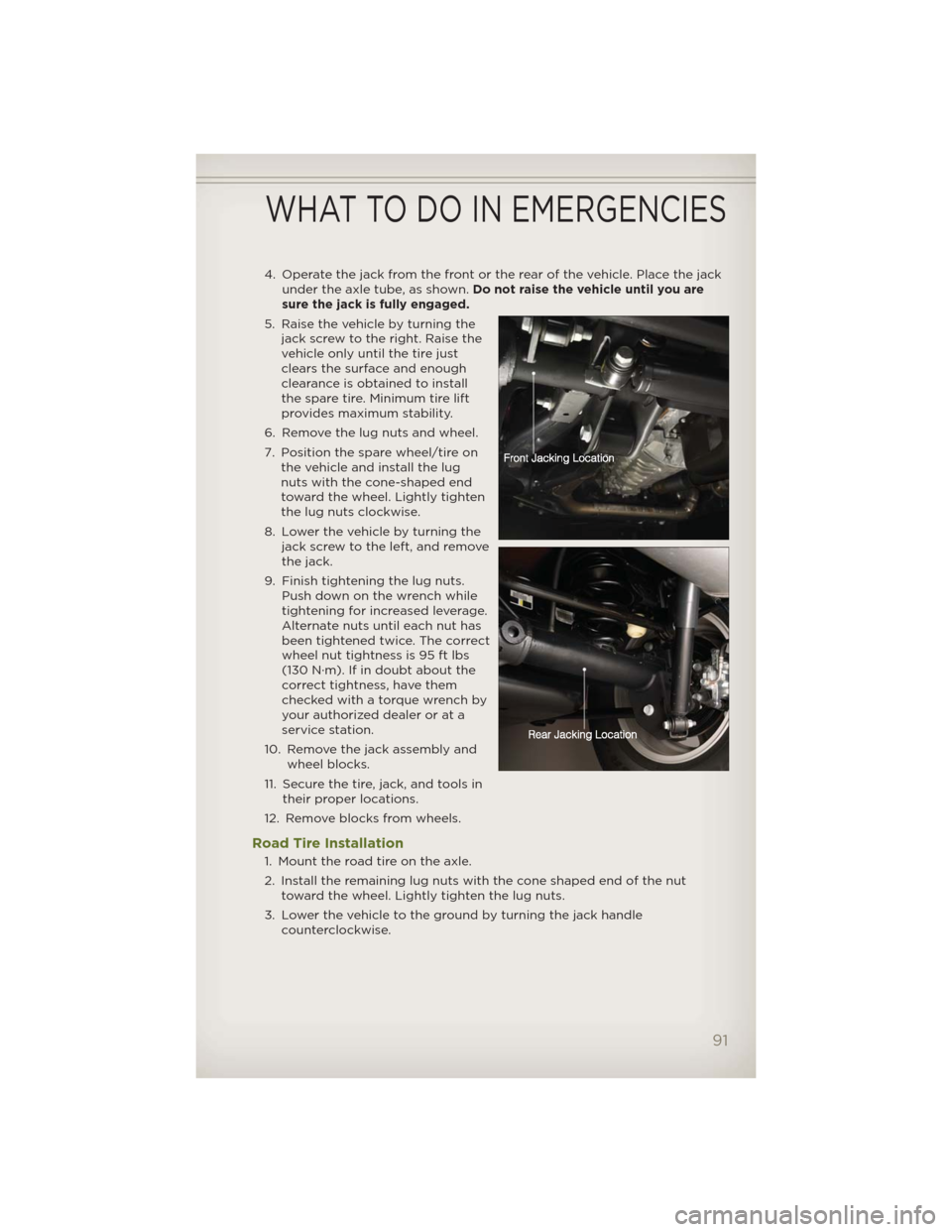
4. Operate the jack from the front or the rear of the vehicle. Place the jack
under the axle tube, as shown.Do not raise the vehicle until you are
sure the jack is fully engaged.
5. Raise the vehicle by turning the
jack screw to the right. Raise the
vehicle only until the tire just
clears the surface and enough
clearance is obtained to install
the spare tire. Minimum tire lift
provides maximum stability.
6. Remove the lug nuts and wheel.
7. Position the spare wheel/tire on
the vehicle and install the lug
nuts with the cone-shaped end
toward the wheel. Lightly tighten
the lug nuts clockwise.
8. Lower the vehicle by turning the
jack screw to the left, and remove
the jack.
9. Finish tightening the lug nuts.
Push down on the wrench while
tightening for increased leverage.
Alternate nuts until each nut has
been tightened twice. The correct
wheel nut tightness is 95 ft lbs
(130 N·m). If in doubt about the
correct tightness, have them
checked with a torque wrench by
your authorized dealer or at a
service station.
10. Remove the jack assembly and
wheel blocks.
11. Secure the tire, jack, and tools in
their proper locations.
12. Remove blocks from wheels.
Road Tire Installation
1. Mount the road tire on the axle.
2. Install the remaining lug nuts with the cone shaped end of the nut
toward the wheel. Lightly tighten the lug nuts.
3. Lower the vehicle to the ground by turning the jack handle
counterclockwise.
WHAT TO DO IN EMERGENCIES
91
Page 94 of 124
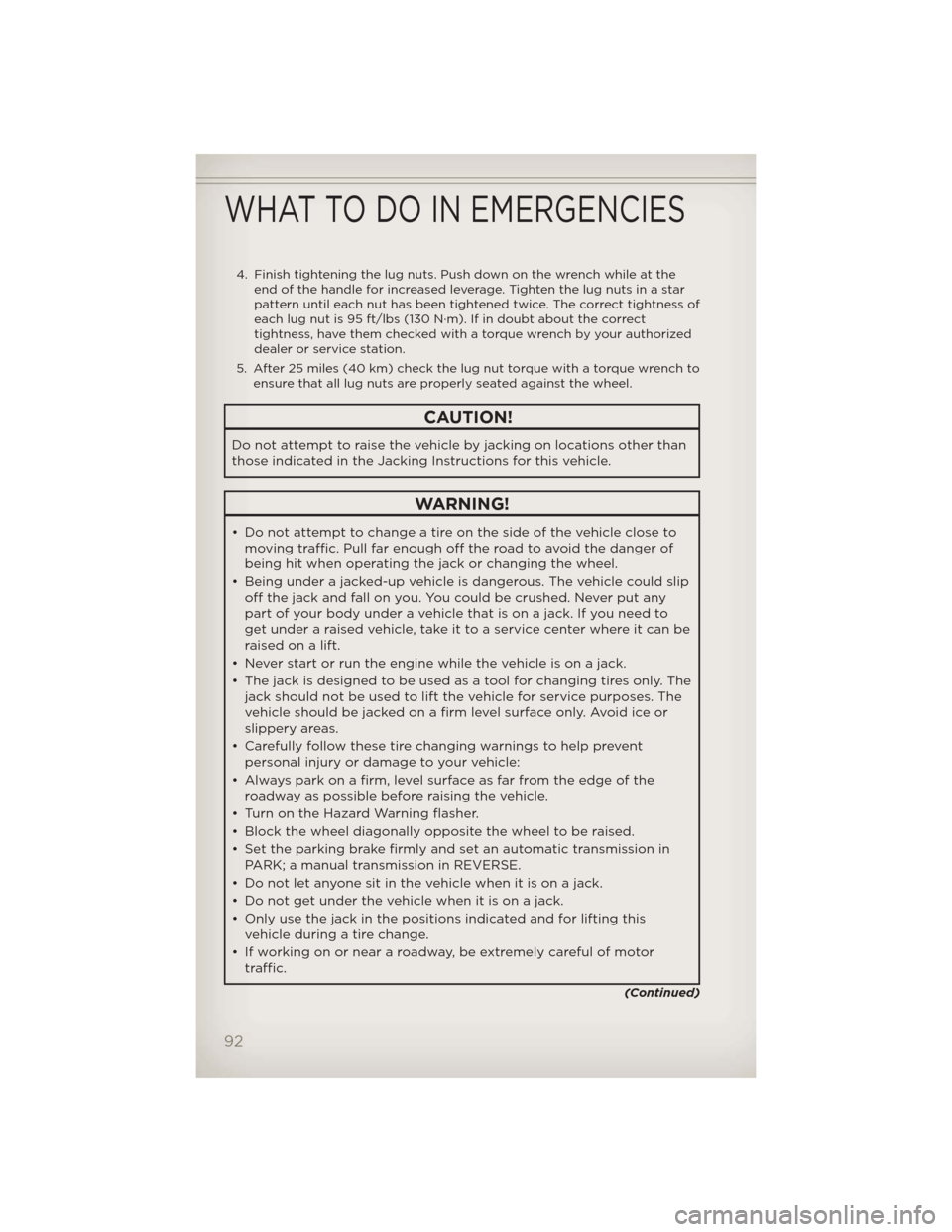
4. Finish tightening the lug nuts. Push down on the wrench while at the
end of the handle for increased leverage. Tighten the lug nuts in a star
pattern until each nut has been tightened twice. The correct tightness of
each lug nut is 95 ft/lbs (130 N·m). If in doubt about the correct
tightness, have them checked with a torque wrench by your authorized
dealer or service station.
5. After 25 miles (40 km) check the lug nut torque with a torque wrench to
ensure that all lug nuts are properly seated against the wheel.
CAUTION!
Do not attempt to raise the vehicle by jacking on locations other than
those indicated in the Jacking Instructions for this vehicle.
WARNING!
• Do not attempt to change a tire on the side of the vehicle close to
moving traffic. Pull far enough off the road to avoid the danger of
being hit when operating the jack or changing the wheel.
• Being under a jacked-up vehicle is dangerous. The vehicle could slip
off the jack and fall on you. You could be crushed. Never put any
part of your body under a vehicle that is on a jack. If you need to
get under a raised vehicle, take it to a service center where it can be
raised on a lift.
• Never start or run the engine while the vehicle is on a jack.
• The jack is designed to be used as a tool for changing tires only. The
jack should not be used to lift the vehicle for service purposes. The
vehicle should be jacked on a firm level surface only. Avoid ice or
slippery areas.
• Carefully follow these tire changing warnings to help prevent
personal injury or damage to your vehicle:
• Alwayspark on a firm, level surface as far from the edge of the
roadway as possible before raising the vehicle.
• Turn on the Hazard Warning flasher.
• Block the wheel diagonally opposite the wheel to be raised.
• Set the parking brake firmly and set an automatic transmission in
PARK; a manual transmission in REVERSE.
• Do not let anyone sit in the vehicle when it is on a jack.
• Do not get under the vehicle when it is on a jack.
• Only use the jack in the positions indicated and for lifting this
vehicle during a tire change.
• If working on or near a roadway, be extremely careful of motor
traffic.
(Continued)
WHAT TO DO IN EMERGENCIES
92
Page 95 of 124
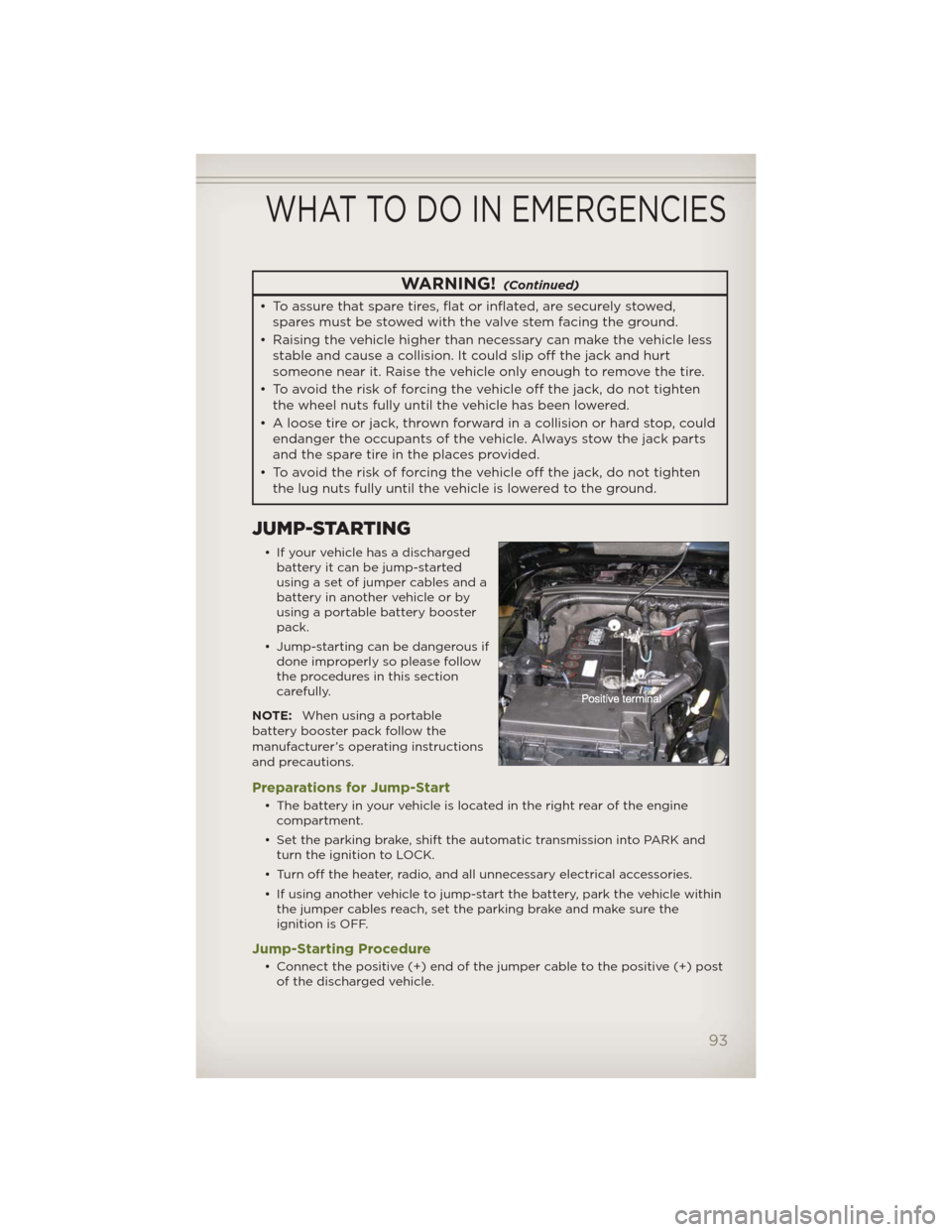
WARNING!(Continued)
• To assure that spare tires, flat or inflated, are securely stowed,
spares must be stowed with the valve stem facing the ground.
• Raising the vehicle higher than necessary can make the vehicle less
stable and cause a collision. It could slip off the jack and hurt
someone near it. Raise the vehicle only enough to remove the tire.
• To avoid the risk of forcing the vehicle off the jack, do not tighten
the wheel nuts fully until the vehicle has been lowered.
• A loose tire or jack, thrown forward in a collision or hard stop, could
endanger the occupants of the vehicle. Always stow thejack parts
and the spare tire in the places provided.
• To avoid the risk of forcing the vehicle off the jack, do not tighten
the lug nuts fully until the vehicle is lowered to the ground.
JUMP-STARTING
• If your vehicle has a discharged
battery it can be jump-started
using a set of jumper cables and a
battery in another vehicle or by
using a portable battery booster
pack.
• Jump-starting can be dangerous if
done improperly so please follow
the procedures in this section
carefully.
NOTE:When using a portable
battery booster pack follow the
manufacturer’s operating instructions
and precautions.
Preparations for Jump-Start
• The battery in your vehicle is located in the right rear of the engine
compartment.
• Set the parking brake, shift the automatic transmission into PARK and
turn the ignition to LOCK.
• Turn off the heater, radio, and all unnecessary electrical accessories.
• If using another vehicle to jump-start the battery, park the vehicle within
the jumper cables reach, set the parking brake and make sure the
ignition is OFF.
Jump-Starting Procedure
• Connect the positive (+) end of the jumper cable to the positive (+) post
of the discharged vehicle.
WHAT TO DO IN EMERGENCIES
93
Page 96 of 124
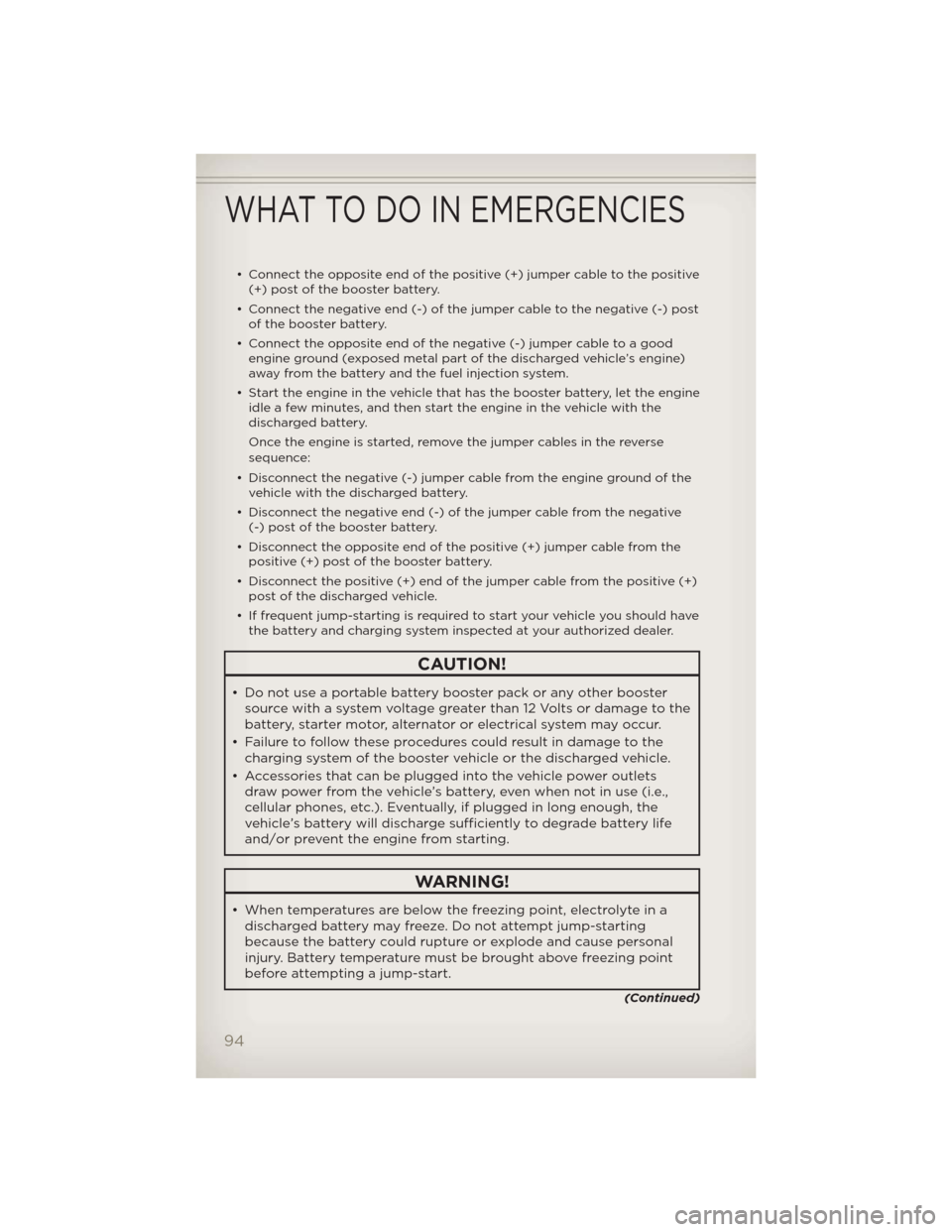
• Connect the opposite end of the positive (+) jumper cable to the positive
(+) post of the booster battery.
• Connect the negative end (-) of the jumper cable to the negative (-) post
of the booster battery.
• Connect the opposite end of the negative (-) jumper cable to a good
engine ground (exposed metal part of the discharged vehicle’s engine)
away from the battery and the fuel injection system.
• Start the engine in the vehicle that has the booster battery, let the engine
idle a few minutes, and then start the engine in the vehicle with the
discharged battery.
Once the engine is started, remove the jumper cables in the reverse
sequence:
• Disconnect the negative (-) jumper cable from the engine ground of the
vehicle with the discharged battery.
• Disconnect the negative end (-) of the jumper cable from the negative
(-) post of the booster battery.
• Disconnect the opposite end of the positive (+) jumper cable from the
positive (+) post of the booster battery.
• Disconnect the positive (+) end of the jumper cable from the positive (+)
post of the discharged vehicle.
• If frequent jump-starting is required to start your vehicle you should have
the battery and charging system inspected at your authorized dealer.
CAUTION!
• Do not use a portable battery booster pack or any other booster
source with a system voltage greater than 12 Volts or damage to the
battery, starter motor, alternator or electrical system may occur.
• Failure to follow these procedures could result in damage to the
charging system of the booster vehicle or the discharged vehicle.
• Accessories that can be plugged into the vehicle power outlets
draw power from the vehicle’s battery, even when not in use (i.e.,
cellular phones, etc.). Eventually, if plugged in long enough, the
vehicle’s battery will discharge sufficiently to degrade battery life
and/or prevent the engine from starting.
WARNING!
• When temperatures are below the freezing point, electrolyte in a
discharged battery may freeze. Do not attempt jump-starting
because the battery could rupture or explode and cause personal
injury. Battery temperature must be brought above freezing point
before attempting a jump-start.
(Continued)
WHAT TO DO IN EMERGENCIES
94
Page 97 of 124
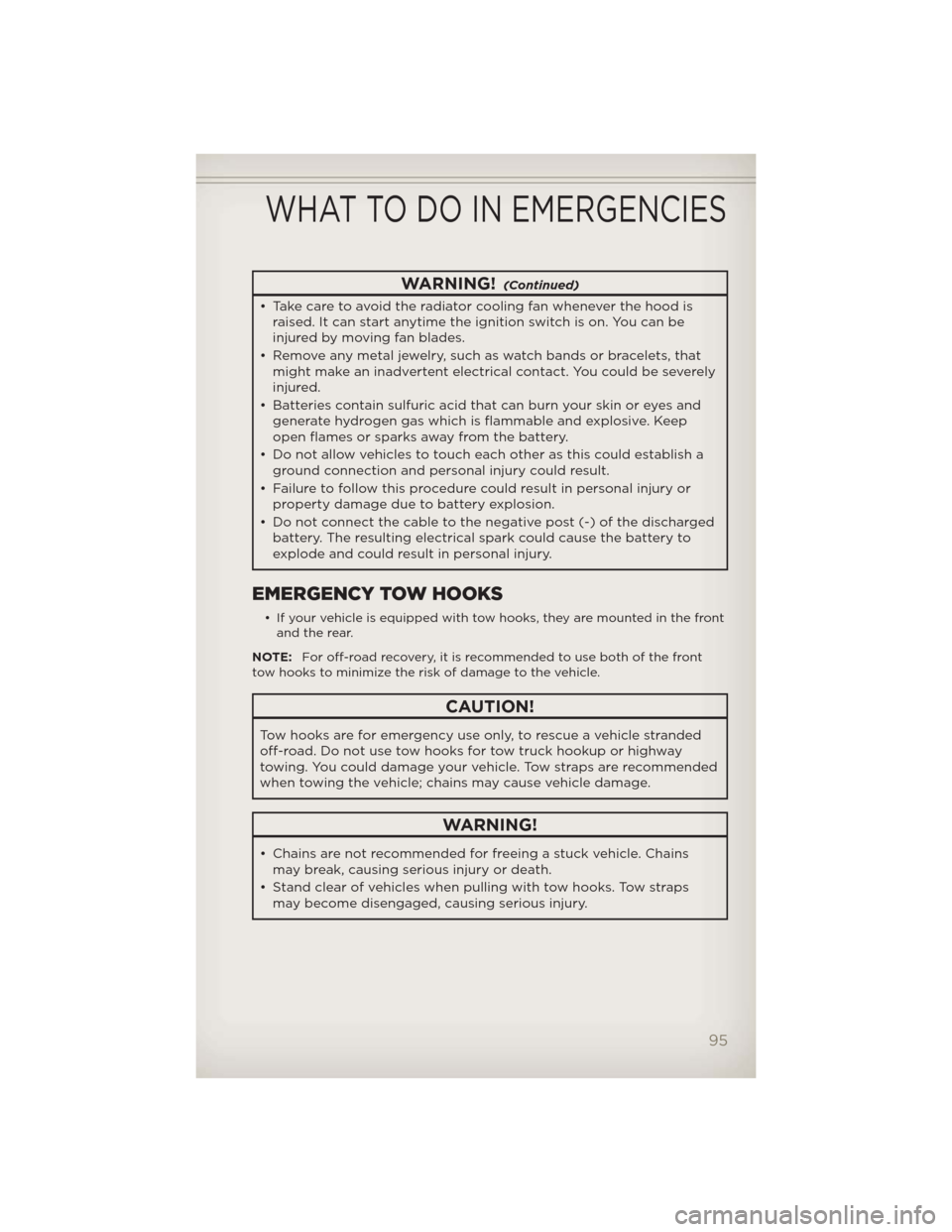
WARNING!(Continued)
• Take care to avoid the radiator cooling fan whenever the hood is
raised. It can start anytime the ignition switch is on. You can be
injured by moving fan blades.
• Remove any metal jewelry, such as watch bands or bracelets, that
might make an inadvertent electrical contact. You could be severely
injured.
• Batteries contain sulfuric acid that can burn your skin or eyes and
generate hydrogen gas which is flammable and explosive. Keep
open flames or sparksaway from the battery.
• Do not allow vehicles to touch each other as this could establish a
ground connection and personal injury could result.
• Failure to follow this procedure could result in personal injury or
property damage due to battery explosion.
• Do not connect the cable to the negative post (-) of the discharged
battery. The resulting electrical spark could cause the battery to
explode and could result in personal injury.
EMERGENCY TOW HOOKS
• If your vehicle is equipped with tow hooks, they are mounted in the front
and the rear.
NOTE:For off-road recovery, it is recommended to use both of the front
tow hooks to minimize the risk of damage to the vehicle.
CAUTION!
Tow hooks are for emergency use only, to rescue a vehicle stranded
off-road. Do not use tow hooks for tow truck hookup or highway
towing. You could damage your vehicle. Tow straps are recommended
when towing the vehicle; chains may cause vehicle damage.
WARNING!
• Chains are not recommended for freeing a stuck vehicle. Chains
may break, causing serious injury or death.
• Stand clear of vehicles when pulling with tow hooks. Tow straps
may become disengaged, causing serious injury.
WHAT TO DO IN EMERGENCIES
95
Page 98 of 124
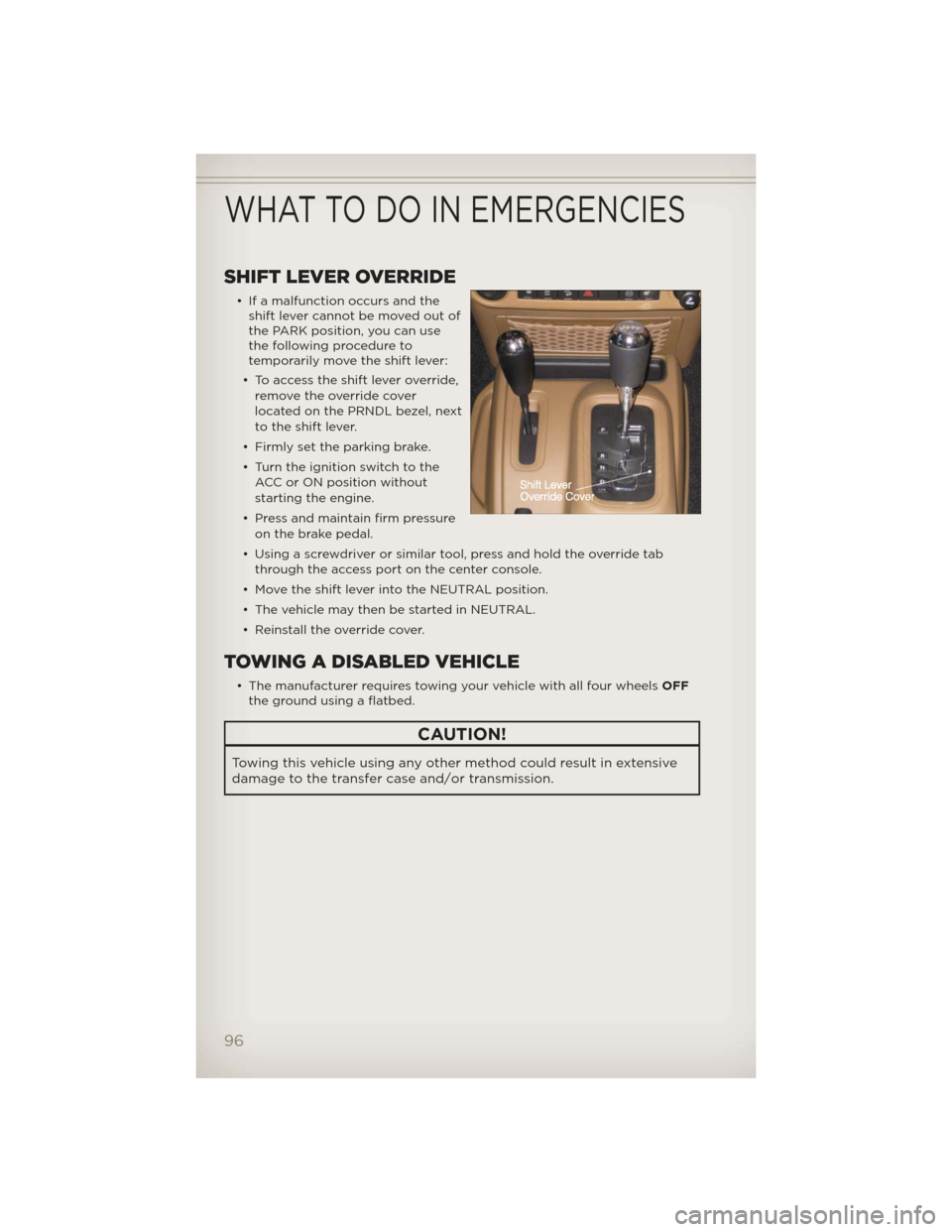
SHIFT LEVER OVERRIDE
• If a malfunction occurs and the
shift lever cannot be moved out of
the PARK position, you can use
the following procedure to
temporarily move the shift lever:
• To access the shift lever override,
remove the override cover
located on the PRNDL bezel, next
to the shift lever.
• Firmly set the parking brake.
• Turn the ignition switch to the
ACC or ON position without
starting the engine.
• Press and maintain firm pressure
on the brake pedal.
• Using a screwdriver or similar tool, press and hold the override tab
through the access port on the center console.
• Move the shift lever into the NEUTRAL position.
• The vehicle may then be started in NEUTRAL.
• Reinstall the override cover.
TOWING A DISABLED VEHICLE
• The manufacturer requires towing your vehicle with all four wheelsOFF
the ground using a flatbed.
CAUTION!
Towing this vehicle using any other method could result in extensive
damage to the transfer case and/or transmission.
WHAT TO DO IN EMERGENCIES
96
Page 99 of 124
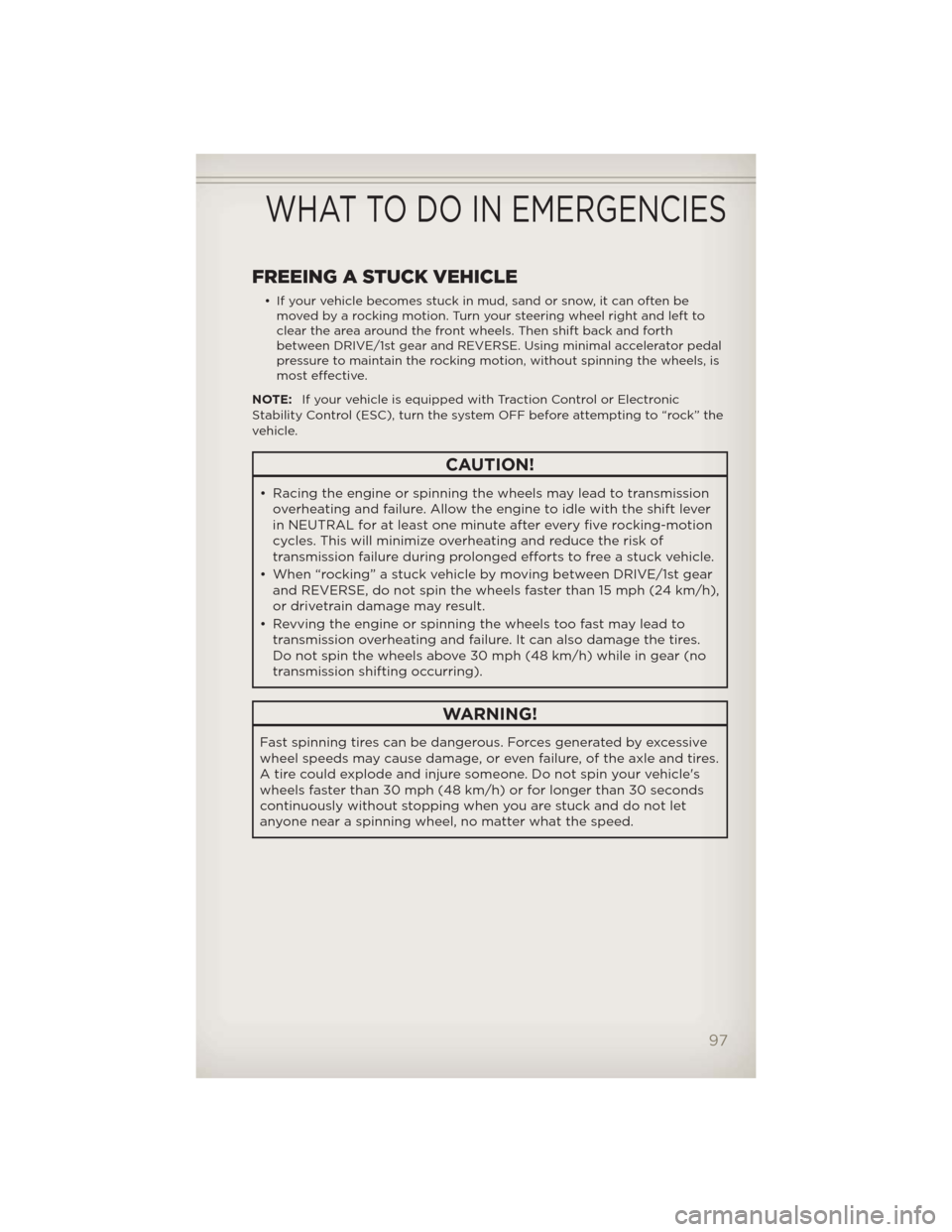
FREEING A STUCK VEHICLE
• If your vehicle becomes stuck in mud, sand or snow, it can often be
moved by a rocking motion. Turn your steering wheel right and left to
clear the area around the front wheels. Then shift back and forth
between DRIVE/1st gear and REVERSE. Using minimal accelerator pedal
pressure to maintain the rocking motion, without spinning the wheels, is
most effective.
NOTE:If your vehicle is equipped with Traction Control or Electronic
Stability Control (ESC), turn the system OFF before attempting to “rock” the
vehicle.
CAUTION!
• Racing the engine or spinning the wheels may lead to transmission
overheating and failure. Allow the engine to idle with the shift lever
in NEUTRAL for at least one minute after every five rocking-motion
cycles. This will minimize overheating and reduce the risk of
transmission failure during prolonged efforts to free a stuck vehicle.
• When “rocking” a stuck vehicle by moving between DRIVE/1st gear
and REVERSE, do not spin the wheels faster than 15 mph (24 km/h),
or drivetrain damage may result.
• Revving the engine or spinning the wheels too fast may lead to
transmission overheating and failure. It can also damage the tires.
Do not spin the wheels above 30 mph (48 km/h) while in gear (no
transmission shifting occurring).
WARNING!
Fast spinning tires can be dangerous. Forces generated by excessive
wheel speeds may cause damage, or even failure, of the axle and tires.
A tire could explode and injure someone. Do not spin your vehicle's
wheels faster than 30 mph (48 km/h) or for longer than 30 seconds
continuously without stopping when you are stuck and do not let
anyone near a spinning wheel, no matter what the speed.
WHAT TO DO IN EMERGENCIES
97
Page 100 of 124
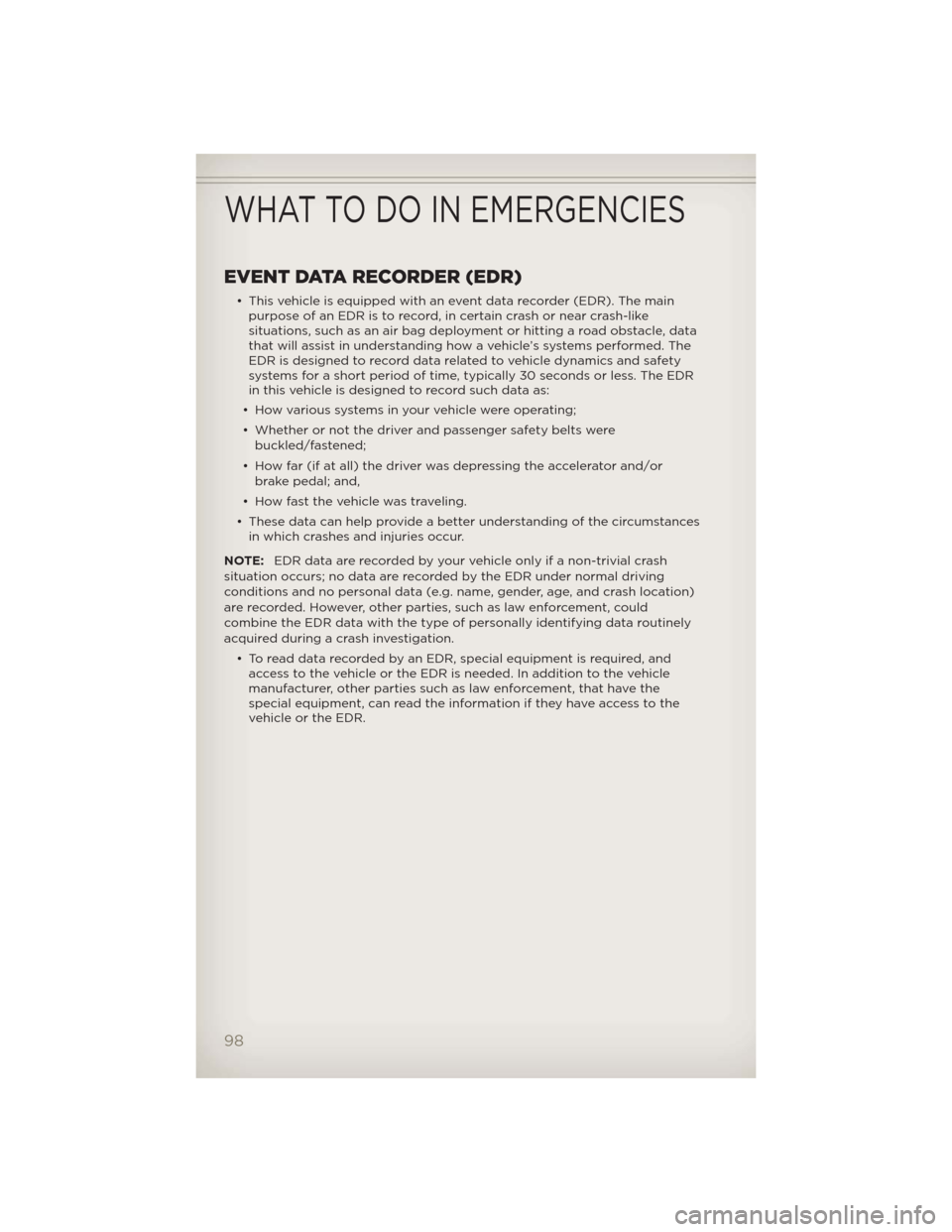
EVENT DATA RECORDER (EDR)
• This vehicle is equipped with an event data recorder (EDR). The main
purpose of an EDR is to record, in certain crash or near crash-like
situations, such as an air bag deployment or hitting a road obstacle, data
that will assist in understanding how a vehicle’s systems performed. The
EDR is designed to record data related to vehicle dynamics and safety
systems for a short period of time, typically 30 seconds or less. The EDR
in this vehicle is designed to record such data as:
• How various systems in your vehicle were operating;
• Whether or not the driver and passenger safety belts were
buckled/fastened;
• How far (if at all) the driver was depressing the accelerator and/or
brake pedal; and,
• How fast the vehicle was traveling.
• These data can help provide a better understanding of the circumstances
in which crashes and injuries occur.
NOTE:EDR data are recorded by your vehicle only if a non-trivial crash
situation occurs; no data are recorded by the EDR under normal driving
conditions and no personal data (e.g. name, gender, age, and crash location)
are recorded. However, other parties, such as law enforcement, could
combine the EDR data with the type of personally identifying data routinely
acquired during a crash investigation.
• To read data recorded by an EDR, special equipment is required, and
access to the vehicle or the EDR is needed. In addition to the vehicle
manufacturer, other parties such as law enforcement, that have the
special equipment, can read the information if they have access to the
vehicle or the EDR.
WHAT TO DO IN EMERGENCIES
98